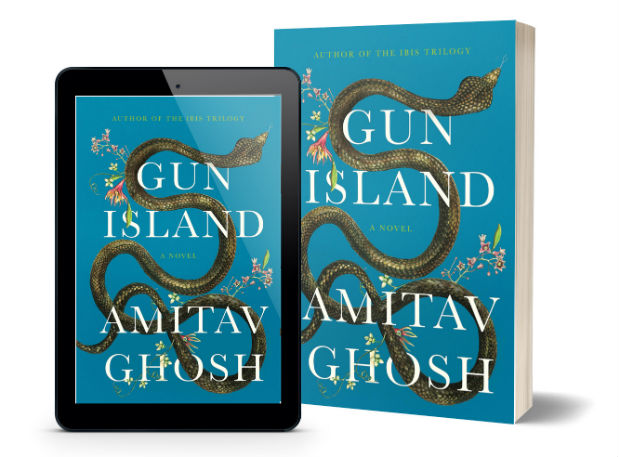For readers of literary fiction, no introduction is needed to works of Amitav Ghosh. He is an acclaimed author of many popular works, has won many accolades including the Padma Shri, Jnanpith and Sahitya Akademi Awards. He has given us many thought-provoking books, “Gun Island” being the latest, published in 2019.
| Book Title | : | Gun Island |
| Author | : | Amitav Ghosh |
| Publisher | : | Farrar, Straus and Giroux (10 September 2019) |
| # of Pages | : |
226 (Hardcover) 3203 KB; 221 (Kindle EBook) |
| # of Chapters | : | 22 |
| Purchase Link(s) | : |
With its central threads of climate change and human migration around the world, this contemporary work was on our list of books to read for a while. And on behalf of Team Thinkerviews, here are my thoughts on the same.
This Is Here In For You
Book Cover:
Being the gateway to the fictional world, a book cover plays a very important role in influencing book purchase and/or reading decisions.

Gun Island by Amitav Ghosh | Book Cover
As the book explores the story of the legend of a goddess of serpents and a “gun island”, the cover page definitely has to show some of the elements of the same. You see a serpent covering the entire page. And Being a legendary goddess you can see various flowers at the curves of the same.
The cover page remains faithful to the story and is moderately attractive. According to me it will influence the viewer/reader positively to go for the book.
Book Plot:
We meet Dinanath Dutta – Deen – a New York based dealer who works with rare books. Like many others, he spends his winters in Kolkata to avoid the severe cold of North America. A chance encounter with a relative leads to him visiting a shrine dedicated to Manasa Devi in Sundarban, but not before we learn about the legend of this goddess of serpents and a “Banduki Sadagar“. The legend tells the story of a Gun Merchant as he went around the world trying to escape the wrath of Manasa Devi, but finding that her creatures found him no matter where he went in the world.
Deen meets Piya and then Tipu and Rafi on his trip to the Sunderban, where Tipu is bitten by a cobra and almost dies. Although Deen leaves for America once Tipu recovers, he can’t shake off this experience. Call it a chance, or the universe moving in mysterious ways, but Deen finds that this visit slowly takes over his life, casting new light on lot of his experiences past and present.
He attends a lecture given by his old friend Cinta who is an expert in Venetian history, learning that the symbols on Manasa Devi’s shrine includes one representing Venice. Venice – Bandiq – was the Gun Island, and so the rest of the legend must also be rooted in real places.
While Deen visits Venice looking for the “Banduki Sadagar”, he runs into none other than Rafi and the whole migrant community of Bangladeshis that call Venice their home. We learn the tale of young people travelling overland from Bangladesh, India, Pakistan, Afghanistan, Iran, Turkey and eventually to Europe. The journey is full of perils, but then the life at home has not much left to offer to these young men, and so it is that this migrants brave fate worse than death.
But is life really as great as they imagined, once they reach their destination, where they will be treated as outsiders and end up doing work that no one else wants to do? With the strong feelings directed against refugees arriving in Europe, what will be the fate of those on the Blue Boat?
Views And Reviews:
Although I picked up this book with no context about the name or the legend associated with it, I found it an easy and enjoyable read. With the legend explored in pieces through different characters, it is almost like puzzle solving – sort of Da Vinci Code at times.
As you start, you might think of the Legend of Manasa Devi as just a story, but as the author develops the legend through multiple characters, each telling a little part of it. From the shrine in Sundarban where the legend is preserved only through telling from one generation to other, to the local entertainment forms telling the story of Mansa Devi to the historical and geographical connections made by characters as they almost re-enact the legend in the modern world, the story will keep you interested. With the elements of the legend overlapping with the real-life, we see that the legend is the symbolic saga that is going to bind all these threads in the end. Manasa Devi has a similar manifestation in African as well as European cultures, whether it is Minoan Goddess of Snakes or the Dark Madonna that blesses Venetians with Health. Manasa Devi is the conduit between the nature and humans.
The book starts with the familiar backdrop of Kolkata playing host to visiting NRIs, but then takes us on a journey to the Sunderban, USA and eventually Venice.
That there is a strange kinship between Venice and Varanasi has often been noted. Both cities are like portals in time; they seem to draw you into lost ways of life. And in both cities, as nowhere else in the world, you become aware of mortality. Everywhere you look there is evidence of enchantment of decay, of a kind of beauty that can only be revealed by long, slow fading.
The characters in this book are very real, vulnerable, each looking for something elusive and unattainable, and paying for their mistakes. Although geographically separated, they all have a connection to each other that keeps propelling them all to the place of conflict. It is a matter of accepting that forces bigger than themselves might be driving their journeys and come to terms with the strange happenings around them. Through their denial, the author also highlights how we are all in denial about big and important issues that affect the world. While we may show moral support for movements for conservations of forests and natural reservoirs, are concerned about climate change and rapid industrialisation of the world, we are not able to force any big changes that will stop such events in near future.
The book showcase in many ways how the human progress is rapidly destroying the environment and its impacts on the animals. As their environment changes faster than they can cope with, these creatures are either dying or migrating to places where they have not been seen before:
There they are, perfectly adapted to their environment, perfectly at home in it – and then things began to change, so all those years of learning become useless, the places you know best can’t sustain you any more and you’ve got to find new hunting grounds.
But this is also true for humans. The world we grow up in, where our parents could pass their knowledge of how to live our lives, also no longer exists. The knowledge and experiences of one generation are considered ‘out of date’ and redundant by the new generation, partly because the world has changed significantly:
We’re in a new world now. No one knows where they belong any more, neither humans nor animals.
Our ancestors had to depend on the soil, the weather, animals, neighbours, family and so on, none of which would yield what they needed just for the asking. Everything they depended on for their livelihood could fight back. Merely to survive, they needed to assert their presence. Today, we live in a world of impersonal systems; we don’t have to impose our presence on a cash machine or our will on the cellphones in order to make them work. In our circumstances, no one needs to assert their presence in order to get by from day to day. And since it is not needed, the sense of presence slowly fades, or is lost or forgotten – it’s easier to let the systems take over.
The access to modern technology, especially the smartphones, is a recurring character in this book. From how the natives of rural Bengal see the world through it to how these are the vital links in human migration networks, the smartphones and the information they push into our lives not only make our daily lives easy, they also make it undesirable. All the glossy products, faraway lifestyles, advertisements focusing on modern gadgets are showcasing the devices that are unattainable and unaffordable in the rural countryside. The future life of green earth, blue sky and country living are replaced by pictures of bustling metropolis and pulsating, exciting lifestyle for young people.
While everyone around us tells us to persue our dreams no matter what, we are forgetting that sometimes chasing a dream can destroy your life. Humans have a right to fantasy and we do dream of big things in life, but not all big things are essentially good for either your well-being or lead to wellness of people around you. While the fictional adventures may inspire you to widen your horizon and explore unknown places, they can also give you expectations that can be fulfilled only in fiction:
In old days, when books were hard to come by, Reading was a way of escaping the narrowland of the world I live in. But was it possible that my world had seemed narrow precisely because I was a voracious reader? After all, how can reality match the world that exist only in books? Books had created dreams and desires that were unsettling and the instruments of my uprooting.
And if mere words could have this effect, what of the pictures and videos that scroll continuously past our eyes on laptops and cellphones? If a picture is worth thousand words, what is the power of billions of images that now permeate every corner of the globe? What is the potency of the dreams and desires they generate, of the restlessness they breed?
Amitav Ghosh has written about the climate change before. And while the whole world was talking extensively about climate change only a few months ago, we are still not seeing the hard decisions being taken by governments. Essentially, no one wants to give up a comfortable, consumption-oriented lifestyle in support of a sustainable future easily. The author has said before that the future generations will question our inaction on this matter and he does make that point again here:
Everybody knows what must be done if the world is to continue to be a liveable place, if our homes are not to be invaded by the sea, or creatures fleeing their natural habitats. We know…and yet we are so powerless. We go about our daily business through habit, as though we were in the grip of forces that have overwhelmed our will; we see shocking and monstrous things happening all around us and we avert our eyes; we surrender ourselves willingly to whatever it is that has us in its power.
And although they may have moved off the centre stage of news, but the refugee situation around the world is not any better. Countless people are leaving their homes in search of a life and arriving to distant shores – legally or illegally. There are still countries who do not accept the refugees and ask them to go back. You may feel differently about human migration, but whether it was under colonial rulers or the “reverse-colonisation” of today, this is a big factor in keeping the economies going. But the humanitarian crisis around refugees is also raising the moral questions to the rest of the world:
If a fleet of civilian vessels shows up to support the refugees, maybe it’ll speak to the world’s conscience. Across the planet, everyone’s eyes are on the Bleu Boat now: it has become a symbol of everything that’s going wrong with the world – inequality, climate change, capitalism, corruption, the arms trade, the oil industry. Maybe now, while there is still time to make changes, people will wake up and see what’s going on.
Summary:
A thought-provoking book that reminds us:
“The limits of human reason and ability become apparent not in the long, slow duration of everyday time, but in the swift and terrible onslaught of fleeting instants of catastrophe.”
Around 8 out of 10.
Quick Purchase Links:
- Buy Book From Amazon India – Paperback
- Buy Book From Amazon India – Kindle EBook
- Buy Book From Amazon US – Paperback
- Buy Book From Amazon US – Kindle EBook
Over To You:
If you already have read the book do share your remarks and thoughts via comments below. Does this review help you in making your decision to buy or read the book? Do not forget to share this article with your friends over various social networks via Twitter, Facebook and others. And yes, you may like to subscribe to our RSS feeds and follow us on various Social networks to get latest updates for the site to land right in your mail box.
 ThinkerViews – Views And Reviews Personal views and reviews for books, magazines, tv serials, movies, websites, technical stuff and more.
ThinkerViews – Views And Reviews Personal views and reviews for books, magazines, tv serials, movies, websites, technical stuff and more.



